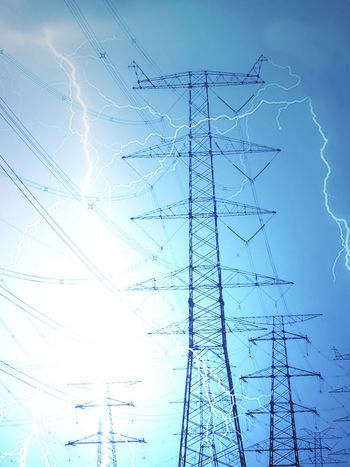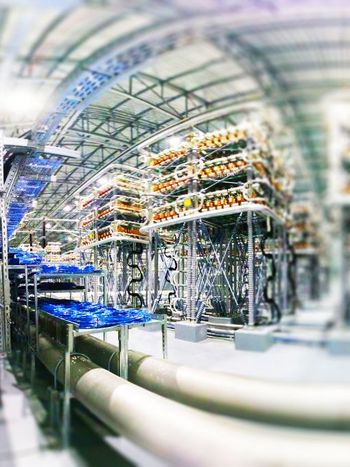Substations and Electrical Installations
By Koji Kawakita, Chair & Samuel Nguefeu, Secretary
This report summarises the Study Committee (SC) B3 “Substations and Electrical Installations” activities in 2021 and updates to April 2022.
Introduction
2021 was a continued challenging year for CIGRE and SC B3 members all over the world. People were restricted to moving only within a country or a limited region.
Under these circumstances, SC B3 made the most of online meetings and conferences to continue communication among members and technical activities such as Working Groups.
We could see a bright sign for the future even in these situations including the following:.
- 2021 VCS (Virtual Centennial Session) was successful in that the B3 Group Discussion Meeting was marked with 268 attendees in total, with 34 contributions including one NGN showcase and two COVID-19 presentations. The session questions and comments amounted to 83 (39 questions and 44 answers and comments). B3 held one workshop jointly with A3 and held one tutorial.
- 2021 A2&B3 Joint Colloquium in Bucharest, Romania was held in a hybrid format. 177 registered participants (on-line and face-to-face), coming from 16 countries. 47 papers were presented during 3 days of technical paper sessions, and two tutorials. The Romanian National Committee of CIGRE made a great effort to realise this hybrid colloquium under the difficult situation.
- B3 also participated in the Ljubljana Symposium 2021 and Kyoto Symposium 2022. B3 held one oral session and one tutorial in Ljubljana and Kyoto respectively.
Substations continue to play a key role as nodes within electrical networks, providing the capability for the network to deliver safe, reliable energy with high availability.
To support the realisation of a sustainable society, substations’ research & development continues to make advances in new technologies and applications that offer substation owners and operators the flexibility, security and stability they need to continue to expand their systems in an efficient and environmentally friendly manner.
The focus area for SC B3 is the coordinated design and operation between transmission and distribution to facilitate more flexible and active distribution networks. Facilitating this connectivity to support the integration of decentralised renewable energy resources, energy storage, and more active customer participation with bilateral power flow is increasingly essential. At the same time, these challenges need to consider asset management practices that can identify the best use of installed assets by optimising their functionality, interventions and lifetime.
The challenges mentioned above have resulted in several new initiatives:
- Dealing with the increased impact on substation design and new applications to support energy transitions such as integration of renewable energy resources, energy storage systems and other installations.
- Mitigating environmental, health, safety and security impacts, including the reduction of Green House Gas emission and the substation carbon footprint
- Substation design, operation and maintenance resilience against natural disaster, threat (terrorism, epidemic, physical/cyber, etc.)
- Optimising substation asset intervention (retrofit, uprating, upgrading, renewal, extensions).
- Increased substation operational efficiency and availability.
- Integration of intelligence for digitalisation.
- New set of skills for new technologies, knowledge transfer and high standards of education in development of engineering skills.
These solutions aim to include the needs of developing communities and emerging economies, as well as those of established industrialised countries.
The SC B3 mission is to:
- Facilitate and promote the progress of engineering and the international exchange of information and knowledge in the field of substations and electrical installations.
- Add value to this information and knowledge by synthesising state-of-the-art best practice and developing recommendations and guidance.
SC B3 has a keen focus on the rapid changes in the utility industry, with an eye on design concepts and new environmentally green and sustainable materials. The goal is to address existing technical needs while developing a bridge to the future.
Strategy and Direction
The SC B3 strategy and direction are continuously reviewed to ensure it meets our stakeholders' needs. Our current strategic plan covers the period from 2018 to 2028. The main technical directions are the following.
T1. New substation concepts:
Development of new concepts including bus arrangements, hybrid solutions, new applications and functions. The impact from distributed generation and power flow control systems including specification of corresponding design/layout criteria for substations constituting integral parts of totally optimised networks. Reduction of carbon footprint impact through new technologies.
T2. Substation ownership issues:
Organisational aspects including human resource and training needs, in-service support, software management including quality control and maintenance. Management of assets including environmental, health, safety, and security.
T3. Life cycle management:
Monitoring in-service experience, substation condition assessment, aspects of maintenance outsourcing, short- and long-term needs, opportunities for cost reduction, spare parts. Increased utilisation (life extension, upgrading, and dynamic loading), refurbishment /renovation concepts, and investment strategies, principles for combining existing and new equipment, accounting for specific demands from network-reliability and customer demand-side points of view.
T4. Integration of intelligence for digitalisation on substations:
New digital technologies (Artificial Intelligence, Internet of Things, 3-Dimensional technology etc.) and applications to be used in all aspects of substation design, operation and management. Identify the opportunities offered from the increased use of advanced information and communication technologies.
A key focus is considering how to improve the opportunities for younger member participation in connection with CIGRE “Next Generation Network” as well as increasing the involvement of women experts in our activities coordinating with the “Women in Engineering” initiative.
Membership and Experts
Our work continues through the support of our national committee representatives, substation specialists and experts from across the globe. We are working with country representatives, 24 regular members plus an additional 4 members representing electricity sectors other than transmission and 17 observer members. Strategic/Customer/Tutorial advisory group and Quality Assurance team also support our work in their respective roles.

Figure 1 - Study Committee B3 Organisational Structure
Working Groups
The Working Groups (WGs) are the “engine room” of CIGRE technical work. Our WG are arranged in 4 key work areas, which facilitate how we organise our work, bringing together our global experts to focus their understanding to achieve our objectives. Area advisors coordinate and align working group activities to the SC B3 Strategy, with responsibilities to support SC B3 Chairperson. Young members are particularly encouraged to join WGs as supporting or active members.
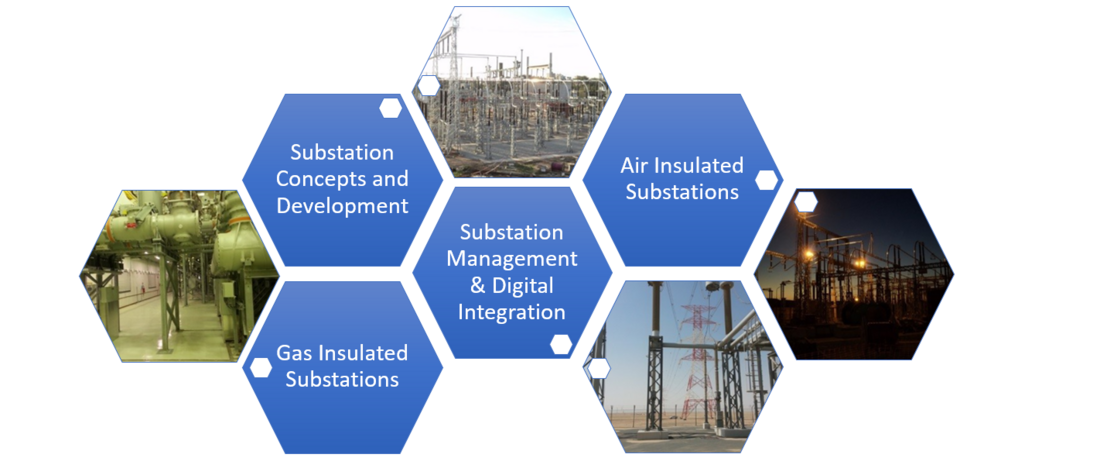
Figure 2 - SC B3 Work Areas
SC B3 has more than 360 experts from across the globe are involved in 13 Working Groups plus 6 Joint Working Groups (4 B3 led and 2 led by other SC) and 1 Green Book project.
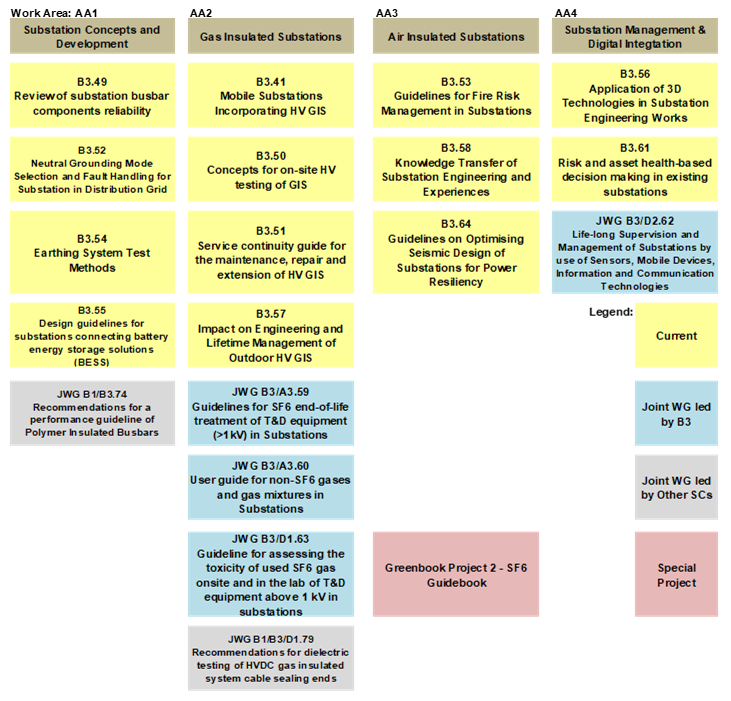
Figure 3 – Study Committee B3 WGs
New WGs that were recently approved include:
- JWG B3/D2.62 - Life-long Supervision and Management of Substations by use of Sensors, Mobile Devices and Information and Communication Technologies
- JWG B3/D1.63 - Guideline for assessing the toxicity of used SF6 gas onsite and in the lab of T&D equipment above 1 kV in substations
- WG B3.64 - Guidelines on Optimising Seismic Design of Substations for Power Resiliency
Many new topics are currently under discussion such as:
- Guidelines for Managing Black Start Resilience in Substations
- Experience in offshore substation operation and maintenance
- LPIT (Low Power Instrument Transformers) with digital interfaces for revenue metering
WGs are not possible without support from National Committees in nominating suitable experts and specialists to participate in the work. We value and encourage all National Committees to review each new terms of reference and to consider appropriate experts available to support them.

CIGRE active Working Groups / Call for experts
Publications
2 Technical Brochures (TBs) were published in 2021 for Study Committee B3 including:
Also, 2 new Technical Brochures were published recently:
The following Working Group Technical Brochures are expected to be completed in 2022:
- B3.41 - Mobile Substations Incorporating HV GIS – Design Aspects
- B3.49 - Review of Substation Busbar Components Reliability
- B3.53 - Guidelines for Fire Risk Management in Substations
- B3.56 - Application of 3D technologies in substation engineering works
- Green Book: SF6 Guidebook - a Springer publication

Tutorials
Tutorials are an important opportunity that shares new knowledge of substation concepts and developments, management and challenges. Tutorials are based on the outcomes of our study in WGs and their associated TBs. Tutorials can be arranged in association with any CIGRE event and are an excellent way for our experts to present their work and share knowledge. Five tutorials ware held in 2021 and to date in 2022.
- CIGRE VCS, 24 August 2021 – “Risk management in substations” by Gerald Buchs (CH)
- 2021 A2 & B3 Joint Colloquium in Bucharest, 9 October 2021 - “Substation servicing and supervision using mobile devices and smart sensing” by Nicolaie Fantana (DE), and “Application of robotics in substations” by Joao Gomes-Mota (SP)
- GCC Power E-conference, 25 October – “Application of non-SF6 gases or gas-mixtures in medium voltage high voltage gas-insulated switchgear”by Maik Hyrenbach (DE) and Gunter Kachelrieß (DE)
- CIGRE symposium Ljubljana 2021 – “LPIT applications in HV gas insulated switchgear” by Robert Luescher (CH)
- CIGRE symposium Kyoto 2022 – “Application of Robotics in Substations” by Jianbin Fan (CN)
Many other topics for Tutorials and Workshops will be presented in 2022.
2021 VCS (Virtual Centennial Session) and B3 annual meeting
The 2021 VCS and B3 annual meeting was held remotely.
The preferential subjects for the 2021 VCS took over from 2020 Session, which demonstrates our commitment to assist asset owners and operators in adapting substations to meet the needs for networks of the future but also to meet the ongoing challenge in managing substations throughout their life cycle, meeting community expectations for health and safety and the environment. The 2020 preferential subjects were:
Preferential Subject 1: Design and Technology
- Impact on design and installation of distributed renewable energy resources, energy storage systems, electric vehicle charging, etc.
- Mitigating environmental; health and safety; and security impacts
- Rapid deployment and cost-effective solutions for electrification of developing communities
Preferential Subject 2: Optimised Substation Management
- Best use of assets by optimising their lifetime.
- Service continuity for maintenance, refurbishment, and replacement.
- Evolution of skills and managing competency
Preferential Subject 3: Integration of Intelligence
- Applications of new technologies, e.g., Internet of Things, Virtual Reality, Augmented Reality
- Challenges and expectations for digital substations
The B3 Group Discussion Meeting was held on the 26-27 August 2021. All contributions in answer to the questions in the B3 special report were broadcasted online and recorded. It was marked by 268 attendees with 34 contributions including one NGN showcase and two COVID-19 presentations. The session questions and comments amounted to 83 (39 questions and 44 answer and comments). During the B3 GDM, B3 working group showcase was presented by WG conveners who volunteered to disseminate their WG activities to attendees.
| WG Title | Presenter |
| B3.55 - Design Guideline for Substations Connecting Battery Energy Storage Solutions (BESS) | Napat Chatrung (TH) Wasin Aphichato (TH) |
B3.53 - Guidelines for Fire Risk Management in Substations | Shinki Noguchi (JP) |
B3.57 - Impact on Engineering and Lifetime Management of Outdoor HV GIS | Toshiyuki Saida (JP) |
B3.50 - Concepts for on-site HV testing of GIS after installation, extension, retrofit or repair | Mark Reuter (DE) |
B3.51 - Service continuity guide for maintenance, repair & extension of HV GIS | Mark Kuschel (DE) |
B3/A3.59 - Guidelines for SF6 end-of-life treatment of T&D equipment (>1kV) in Substations | Günter Kachelrieß (DE) |
B3/A3.60 - User guide for non-SF6 gases and gas mixtures in Substation | Piet Knol (NL) |
B3.56 - Application of 3D Technologies in Substation Engineering Works | Philip Konig (ZA) |
B3.48 - AHI for equipment in existing substations and B3.61 - Risk and asset health based decision making in existing substations | Alan Wilson (GB) |
The Study Committee B3 annual meeting was held successfully on 23 August. Daniel Stafford, B3 liaison of NGN and Cinthia Souza Dos Santos Xavier, member of WiE were invited to the annual meeting to present each organisations activities and discussions with B3 members for mutual understanding.
The next annual meeting for Study Committee B3 will be held in person on 1 September during the 2022 CIGRE Session.

Figure 6 – Study Committee B3 online annual meeting group photo
Events
Upcoming special events for the SC B3 include:
- Foz do Iguaçu, Paraná, Brazil - X WORKSPOT, 27-30 November 2022
- Paris, France – 2022 CIGRE Session, 28 August – 2 September
- Birmingham, UK – 2023 SC B3 and A3 Joint Colloquium
Awards
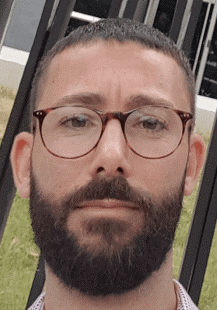
CIGRE Technical Council Award
This award is granted to a few CIGRE Members as a reward for their active participation in the activities of the technical work of the Study Committees. In 2021, the award was delivered to Romain Migne (FR) in recognition of his outstanding contributions to the life and work of the Study Committee. Romain participated in a lot of B3 Working Groups and the secretary of the WG B3.32. He served as the SC B3 secretary from 2014 to 2020.
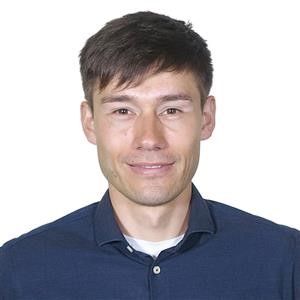
CIGRE NGN Significant Contribution Award
This award is intended to recognise the outstanding contributions of NGN members to CIGRE activities. In 2021, the award was delivered to Jens Hettler, the secretary of WG B3.51 “Service continuity guide for the maintenance, repair and extension of HV GIS”. This award encourages other NGN members working under SC B3 activities.
CIGRE SC B3 Outstanding Service Award
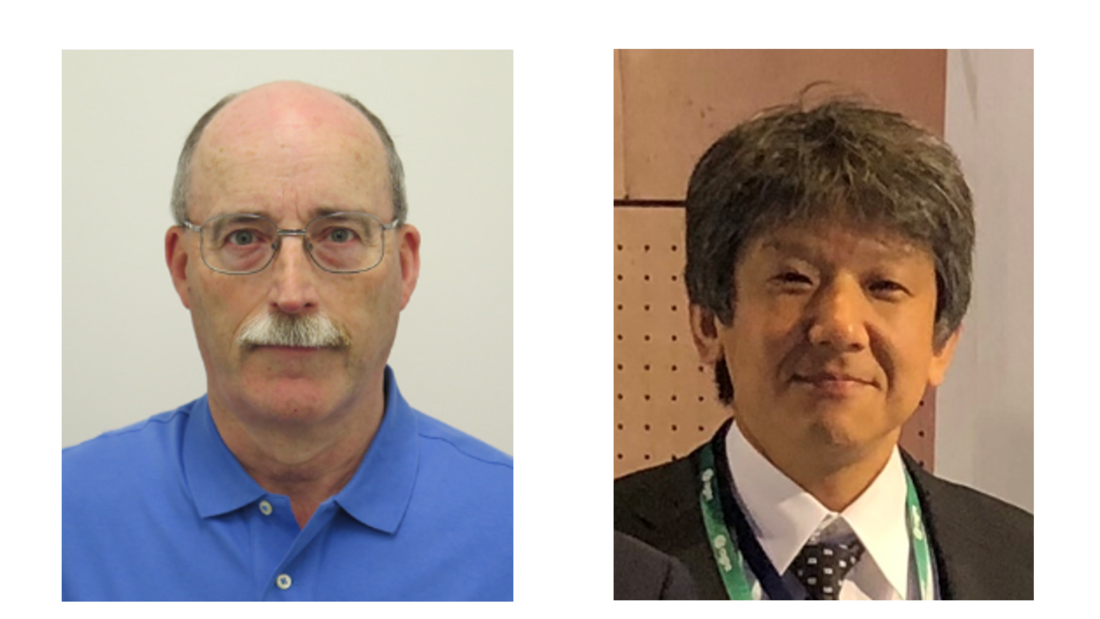
The Outstanding Service Award of CIGRE SC B3 is granted by the SC Chair annually to two of its members in recognition of outstanding participation in and contribution to the SC's technical work. In 2021, this award was delivered to Colm Twomey (IE) and Toshiyuki Saida (JP). Colm is currently SC B3 regular member and has played many important roles such as contributor of the Substation Greenbook, B3 Poster Session convener (2016 to present), and many WG member.
Toshiyuki is Gas Insulated Substation (GIS) expert. He participated in B3 Working Groups. He is currently the Convener of WG B3.57 “Impact on Engineering and Lifetime Management of Outdoor HV GIS.
Conclusions
As Chairperson, I am extremely grateful for the support of our members and experts for their patience and dedication to make remote work under the current situation. I also appreciate members’ organisations to support them as we continue developing the future power network. SC B3 continues to keep an eye on the utility industry's rapid changes and works on new challenges with our experts for an environmentally friendly and sustainable future.
Finally, I wish all our members to stay safe and healthy, and I hope to see you all soon.

